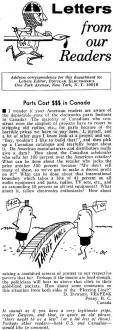Parts Cost $$$ in Canada
|
|
Today's ready availability of just about everything from just about everywhere is something even we who have been around a long time take for granted. Trade barriers have been drastically lowered or completely removed for products not vital to national security - unless of course enough money is paid to politicians to rule otherwise (e.g., uranium ore and ICBM stabilization systems). This letter to the editor of Popular Electronics appeared in a 1965 issue lamenting the severe price mark-up of common electronics components - in particular those mentioned for projects in the magazine. The currency exchange rate between the U.S. and Canada in 1965 was 1 CAD - Canada [Canadian dollar / $ CA] = 0.93 USD - United States [US dollar / $], so the 7% difference did not even come close to accounting for the kinds of price differences cited by reader Dawson (exchange rate as of today is0.78 USD). Part of the additional mark-up was due to shipping into Canada and probably tariffs (I couldn't find a specific tariff rate, but 10% was typical in 1965). Letters from Our Readers - Parts Cost $$$ in Canada
Letters Editor, Popular Electronics One Park Avenue, New York, N. Y. 10016 Parts Cost $$$ in Canada I wonder if your American readers are a ware of the deplorable state of the electronics parts business in Canada? The majority of Canadians who construct even the simplest of projects have to resort to stripping old radios, etc., for parts because of the horrible prices we have to pay here. I, myself, and a lot of other guys I know look at a project and say, "Boy, wouldn't I like to build that!", and then pick up a Canadian catalogue and tearfully forget about it. Do American manufacturers and distributors really give a darn? How about the Canadian wholesaler who sells for 300 percent over the American retailer? What can be done about the retailer who jacks the price another 300 percent because "We don't sell many of these, so we've got to make a decent profit on it?" What can be done about that international boundary which takes a bite of 43 percent on all audio equipment and parts, radios, TV sets, etc., and an astounding 50 percent on all test equipment? What about it, fellow electronics enthusiasts? How about raising a combined scream of protest to our respective powers that be? Perhaps if the moans are loud enough, the politicians will hear us above that clink in their gold-lined pockets. How about some comments on this situation from both sides of the "Fleecing Line?" D. Dawson, VE6PE4K Penny, B. C. Canada It sounds as if you have a very legitimate gripe, reader Dawson, and that, to quote an old phrase, "there ought to be a law" (or a lot less of them). Perhaps other readers - both U.S. and Canadian - would like to comment. More Humor Wanted In the many years I have been a subscriber to Popular Electronics I have seldom had as good a laugh as I did over the "Odds 'N' Ends" column on page 124 of the November, 1964, issue. I would like to see more of the same. Also, what happened to "Hobnobbing with Harbaugh" in the October and November issues? Dan Searle Antigua, British West Indies Pico vs. Micromicro Please use standard symbols in your construction articles. In the "Wireless Re-Broadcaster, " January, 1965, the symbol "pf," was used as well as "μf" I never saw "pf." used before, but I imagine it means "micormicrofarads." Darrel Bender Camp Hill, Pa. You're right, Darrel; "pf." means the same as "μμf." As we pointed out in the July, 1964, "Letters from our Readers" column, "pico" was one of the unit prefixes recently adopted by the International Committee on Weights and measures. it means (as does "micromicro") 10-12.
Posted March 1, 2018 |
|

